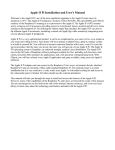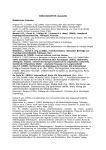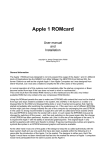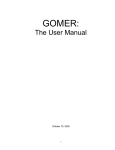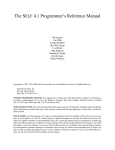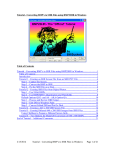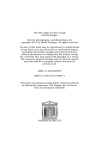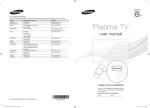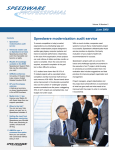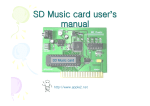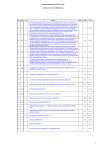Download Apple II Pi Installation and User`s Manual
Transcript
Apple II Pi Installation and User's Manual Welcome to the Apple II Pi: one of the most significant upgrade to the Apple II series since its inception in 1977. The Apple II Pi integrates a modern 32-bit CPU/GPU core with 256 or 512 MB of RAM, SD memory card storage, and USB ports all courtesy of the Raspberry Pi computer, into the Apple II computer. The Apple II remains active, acting as an I/O processor, providing access to its keyboard, mouse, joystick and drives to Linux running on the Raspberry Pi. GSport, an Apple IIgs emulator running on the Raspberry Pi under Linux, has access to the physical Apple II peripherals while outputting digital video on the Raspberry Pi's HDMI port (optionally the Pi's composite video output). GSport can emulate a maxed-out Apple IIgs running at about 20 MHz and 8 MB RAM. The Apple II Pi's operating system is Raspbian, a port of Debian – an industrial strength, modern Linux distribution for the Raspberry Pi. Apple II Pi is a very sophisticated product. It can be as complicated as you want it to be, or as easy as you want (and willing to buy). Your dealer will have options available from a plug-in, turn-key system to a build-it-yourself kit. You will have to become somewhat familiar with Linux, even if it is just the log in procedure. But the more you invest, the more you will get out of your Apple II Pi. The Apple II Pi can run the full suite of Raspbian software packages available for free, including web browsers, mail clients, powerful office productivity applications, and a full spectrum of programming tools. And, of course, you will have almost every Apple II application and game available, using your real Apple II hardware. This manual will take you through the steps to install and access the features of the Apple II Pi. However, many of the capabilities of the Raspberry Pi, and Linux, are beyond the scope of this manual. You are encouraged to use the links at the end of this manual, Internet resources, and even your local library to learn more about the technology and features included with the Apple II Pi. Table of Contents Part I: Installation............................................................................ 3 Step 1: Identifying the parts....................................................................3 Step 2: Raspberry Pi Raspbian Setup.......................................................3 Step 2.1: Apple II Pi Update and Upgrade.................................................4 Step 3: Apple II Setup.............................................................................5 Step 3.1: Apple II configuration...............................................................5 Step 4: Installing the Apple II Pi adapter card...........................................5 Step 5: Booting Up..................................................................................5 Step 6: Keeping Apple II Pi Updated.........................................................6 Troubleshooting: Hmmm, that didn't work................................................7 Part II: Client/Server Start-up...........................................................8 A2PI:........................................................................................................................ 8 a2pid:...................................................................................................................... 8 Part III: User Input...........................................................................9 Keyboard Input:......................................................................................9 Keyboard Mapping:.................................................................................................. 9 Mouse Input:........................................................................................10 Gameport Input:...................................................................................10 a2joy:..................................................................................................................... 10 a2joymou:.............................................................................................................. 10 a2joypad:............................................................................................................... 10 Part IV: FUSE ProDOS driver............................................................11 fusea2pi:..............................................................................................11 a2mount:..............................................................................................11 fusermount:..........................................................................................12 Part V: GSport Apple IIgs Emulator..................................................13 Keyboard Input:....................................................................................13 Joystick Input:......................................................................................13 Apple II storage media:.........................................................................13 Part VI: Tools.................................................................................15 Interactive Tools:..................................................................................15 a2mon:.................................................................................................................. 15 a2term:.................................................................................................................. 15 Development Tools:...............................................................................15 bload:..................................................................................................................... 15 brun:...................................................................................................................... 16 Floppy Disk Image Tools:.......................................................................16 dskread:................................................................................................................. 16 dskwrite:................................................................................................................ 16 Supplemental Files:..............................................................................17 bintomon:.............................................................................................................. 17 merlin2text:........................................................................................................... 17 text2merlin:........................................................................................................... 17 a2libc:.................................................................................................................... 17 a2slideshow.mon:.................................................................................................. 17 a2slideshow.bin:.................................................................................................... 18 execfile:................................................................................................................. 18 Part VII: Advanced Configuration....................................................19 Loading joystick driver at boot time:......................................................19 Mounting ProDOS devices automatically:...............................................20 Creating a Special Apple IIgs User:........................................................21 Step 1: Create user apple2...................................................................................21 Step2: Install GSport.............................................................................................. 22 Step 3: Create login script:.................................................................................... 22 Modification for Composite Output:.......................................................23 Appendix:...................................................................................... 24 Part I: Installation. These instructions will lead you through setting up the Raspberry Pi to connect with your Apple II. This is a multi-step process; make sure you follow the instructions closely. It might help to read through the steps before attempting it live. If you feel uncomfortable with any of the steps, or need further clarification, email me at [email protected] I will try my best to answer your question(s) about the installation process. But be forewarned, this is a sophisticated product and will require some amount of technical expertise with the Apple II and especially the Raspberry Pi running Linux. Step 1: Identifying the parts. You should have in your possession a Model A or Model B Raspberry Pi computer. The Apple II Pi adapter card, labeled as such at the top, is the connection between the Raspberry Pi and the Apple II. It provides power and communications channel between the two. The Apple II Pi card has a female header at the top where the Raspberry Pi's GPIO header plugs in. The orientation is such that the USB ports stick out the front, the SD card sticks out the back (over the top of the chips on the adapter card), and the HDMI port is at the bottom. Refer to the following picture for clarification: Note that the composite video port and the audio headphone jack are oriented upwards. Due to the limited space inside the Apple II case, these ports are inaccessible without additional hardware modification. The HDMI port, oriented at the bottom, requires a 90 or 270 degree adapter for access. Some HDMI cables can be bought with this angle built-in and tend to have more clearance than just the adapter. Depending on the slot you want to plug your Apple II Pi in to, the 90 or 270 degree adapter will provide the access to the HDMI port and clear the motherboard standoffs. If your monitor only has a DVI connection, you will need either a HDMI ↔ DVI cable or HDMI ↔ DVI adapter. All of these cables and adapters can easily be found on Amazon.com (links in Appendix). Refer to the following pictures to see which adapter/cable you need for your installation: 90 degree HDMI adapter 270 degree HDMI cable The USB (and Ethernet on Model B Pi) ports are easily accessed at the front end of the card. Step 2: Raspberry Pi Raspbian Setup. Raspbian is the Debian Linux distribution customized for the Raspberry Pi. Basic knowledge of Debian Linux is required for the successful installation and operation of the Apple II Pi. Refer to the Appendix for links to helpful sites if needed. It is easiest, but not required, to set up the Raspberry Pi outside the Apple II. You will need a USB keyboard and mouse to set up Raspbian as well as the monitor+cable+angle-adapter you plan on using when installed in the Apple II. You can, of course, setup the Raspberry Pi inside the Apple II, but the Apple II keyboard and mouse won't be available until after the installation is complete. Option 1: Purchase pre-configured SD card from dealer. This is by far the easiest option. Insert the pre-configured SD card into the Raspberry Pi and continue to Step 2.1. Option 2: Download pre-configured Apple II Pi image. Download the pre-configured image from (TBD) and copy the image to your SD card (http://elinux.org/RPI_Easy_SD_Card_Setup). Insert the SD card into the Raspberry Pi and continue to Step 2.1. Option 3: Download official Raspbian image and setup. This is the most involved, but most flexible, option. First, download the official Raspbian image from the Raspberry Pi Foundation (http://www.raspberrypi.org/downloads) and copy to your SD card (http://elinux.org/RPI_Easy_SD_Card_Setup). Insert the SD card and boot the Raspberry Pi. The initial boot will automatically run raspi-config, the Raspberry Pi configuration program (http://elinux.org/RPi_raspi-config). Once you have configured Raspbian, expanded the file system, and reboot, login as the default user 'pi', password 'raspberry'. Download and install the Apple II Pi package using the following commands: wget schmenk.is-a-geek.com/tarfiles/a2pi_armhf.deb sudo dpkg -i a2pi_armhf.deb An additional package is required for the GSport emulator running in the X GUI. Install it with: sudo apt-get install xfonts-base Once the packages have been installed, it's time to update all the packages available. Continue to Step 2.1. Step 2.1: Apple II Pi Update and Upgrade. Debian is well known for its solid packaging system to manage software packages. You will do this whenever you want to get your system up-to-date, including now. Enter these commands: sudo apt-get update sudo apt-get upgrade If there is an update for the Apple II Pi package, you may get a message about it being from an untrusted or unverified source. Go ahead and install it – I really am pretty trustworthy. Step 3: Apple II Setup. The other half of the Apple II Pi equation is the software that runs on the Apple II itself. This is the boot floppy that you will start your Apple II from. If you have a different boot media, you can move the files over to that device for booting, as long as it is ProDOS based. ProDOS 1.9 is on the floppy; compatible with all Apple IIe’s and later models. Option 1: Purchase boot floppy from dealer. This is the easiest way to get a boot floppy. Proceed to Step 3.1 Option 2: Create boot floppy from disk image. Installed from the a2pi package: /usr/share/a2pi/A2PI-x.y.PO (x.y represent the current version, i.e. 1.2) is a ProDOS image of the 5¼ boot floppy. There are a number of ways to create a physical floppy image, but the easiest is probably ADTPro (http://adtpro.sourceforge.net). Once the floppy image has been written to a physical floppy, continue to Step 3.1. Step 3.1: Apple II configuration. On the boot floppy is a program, CONFIG. If you plan on installing your Apple II Pi in a slot other than 7, or on a system containing a Super Serial Card, you must run this program to set the slot number. The Apple II Pi adapter card will run just fine in slot 3, if that makes your choice any easier. Slot 7 probably has the least clearance issues, though. Step 4: Installing the Apple II Pi adapter card. Connect the Raspberry Pi to the Apple II Pi adapter card with the GPIO header. If you received a PCB standoff to further solidify the Raspberry Pi ↔ adapter card connection, insert it first into the adapter card. Very carefully, align the GPIO header pins with the adapter card header and firmly press together. Make sure the standoff inserts into the hole in the Raspberry Pi. Double check that the GPIO pins are all inserted into the header properly, no pins should be exposed. Connect the HDMI adapter (or cable with built-in adapter) to the HDMI port on the Raspberry Pi. Make sure the slot selected in the CONFIG program is clear of other cables and carefully maneuver the Apple II Pi into the slot. When pressing the card into the slot, press on the adapter card, not the Raspberry Pi itself. Make sure the HDMI adapter/cable has clearance around the front of the slot. Connect the HDMI cable to the adapter. Run the cable underneath any other expansion cards out one side or the other. Some HDMI cable plugs are a tight fit through the access panels in the back of the Apple II. Find the best fit, but you may have to shave the plug down somewhat to allow it to exit the Apple II case. Connect the Ethernet cable, if needed, or USB extension cable for Wi-Fi dongle. I have found the RFI shielding inside the Apple II case severely restricts the range of the Wi-Fi dongles, so a USB extension cable to move the dongle external to the Apple II case is required. Once installed, it should look like this (slot 7): Insert the other end of the HDMI cable into an appropriate monitor. Another option is to use an HDMI ↔ DVI cable or adapter in order to use a dedicated computer monitor. Older 4:3 aspect ratio monitors may have a more appealing aesthetic with the Apple II than newer wide-screen monitor/TVs, and most of them are DVI only. Step 5: Booting Up. Insert the boot floppy into drive 1 and turn on the Apple II. The Apple II should start its floppy boot sequence and the Raspberry Pi should identify the digital monitor and display its boot process. Sometime into the boot process, if all is OK, the Apple II will beep when it established communication with the Raspberry Pi. Welcome to the Apple II Pi. You can login using the Apple II keyboard and navigate the X Desktop with the Apple II mouse if you have one. If you don't have an Apple II mouse, or prefer a USB mouse, plug it in to the USB port on the Raspberry Pi. Both mice can be active simultaneously. Ditto for the keyboard: plug in a USB keyboard if you want to supplement the Apple II keyboard (which lacks many modern keys). Continue on to the rest of the Apple II Pi documentation to see how you can interact with your Apple II devices and use the GSport emulator to turn your Apple II into the ultimate IIgs upgrade. Step 6: Keeping Apple II Pi Updated. Debian Linux, of which Raspbian is a port of, is known for it’s powerful package system that makes installing software and maintaining your system very easy. Whenever you want to update your system, issue the commands from Step 2.1: sudo apt-get update sudo apt-get upgrade This will install all available updates. When upgrading the a2pi package, the Apple II keyboard may become unresponsive – press Ctrl-Reset to re-establish communication between the client and server. If you find an update to the Apple II Pi boot floppy, you can easily overwrite the floppy in drive 1, slot 6 with this command: dskwrite /usr/share/a2pi/A2PI-x.y.PO (x.y represent the current version, i.e. 1.2). Label your floppy disk so you know what version it is. You will be prompted to overwrite the existing volume; respond with ‘y’. Afterward, you will also need to re-run the CONFIG program to set the slot # for the Apple II Pi adapter. Exit the Apple II client with Open-Apple+Solid-Apple+Delete key combination. Type: run config Enter the slot #. Then to re-connect to the Apple II Pi server: run startup There shouldn’t be many updates to the boot floppy. Troubleshooting: Hmmm, that didn't work. Hopefully you had no problem getting the Apple II Pi working. But, if you did, here are a few things to try: • Did the Apple II turn on? Although the Raspberry Pi is a very low-power computer, there is a chance it could overwhelm a fully loaded Apple II. Triple check that the Raspberry Pi is plugged into the header correctly. Then, try removing everything except the Apple II Pi adapter card and the floppy controller card. If is still doesn't turn on, try removing the Apple II Pi card. If it does turn on, remove the Raspberry Pi from the adapter card and try the empty adapter card. If it still doesn't turn on, the adapter card may be defective. Call your dealer. If the Apple II won't boot with the Raspberry Pi properly connected, your power supply may be on the edge and need replacing. • Did the Pi turn on? Triple check that the Pi is properly connected to the header on the adapter card. Is the SD card firmly connected? If it still doesn't turn on, remove it and try it with a wall wart adapter that is known to work. Does it work with the wall wart adapter? If so, your Apple II power supply may be on the edge and need replacement. • Did the Pi turn on, but no video? Have you tried the monitor+cable+angle-adapter before with the Pi? If it worked earlier, check all the connections when it's inserted into the Apple II. Some DVI monitors need a boost setting that can be found in the /boot/config.txt file. • Did both turn on, but no connection beep? Is the Apple II sitting there with a spinner icon in the corner? This is probably because the Apple II client code is looking in the wrong slot for the Apple II Pi adapter card. Press any key to exit the Apple II client and type 'run config' to run the Apple II Pi configuration program. Double check the slot assignment for the Apple II Pi adapter card and enter the value. It will be saved. Type 'run startup' to establish communication with the Raspberry Pi. If this still doesn't work, you may have a defective adapter card or Raspberry Pi. Call your dealer. • Everything connects but the keyboard is erratic? Don't forget you are using a ~30 year old keyboard. It may need some cleaning or use to remove oxidation from the key switches. There are many resources on how to clean an Apple II keyboard, but pressing the troublesome key a few hundred times might just clear it up. Part II: Client/Server Start-up. The Apple II Pi computer runs as two parts: the Apple II's 6502 processor is running a special device driver under BASIC in ProDOS. This device driver send keyboard and mouse events to a special background process running in Linux on the Raspberry Pi, known as a daemon, accepts the input events from the Apple II and inserts them into the Linux input subsystem where they are made available to applications. This daemon can also receive command requests from other Linux tasks and pass them down to the 6502 on the Apple II. Memory ranges on the Apple II can be read and written, as well as control passed to routines on the Apple II. The protocol to pass control back and forth between the Apple II and Raspberry Pi was carefully designed to be robust and efficient. This protocol, and the interface for external tasks, is what gives the Apple II Pi the ability to provide many different functions of the Apple II to programs running on the Raspberry Pi, all apparently simultaneously. A2PI: When the Apple II is turned on, the Raspberry Pi begins it's boot process in parallel with the Apple II boot procedure. The Apple II will run the STARTUP program on the A2PI floppy and wait for the daemon to establish a connection. a2pid: On the Raspberry Pi, Linux will automatically start its list of services, one of which is the Apple II Pi daemon: a2pid. When the a2pid daemon synchronizes with the Apple II client, the Apple II will give its familiar beep, and the two computers will become one. Linux will complete the boot process and present the 'login:' prompt at the console for the user to log in. Apple II Pi retains the default Raspbian user name of 'pi' and password 'raspberry'. Use these credentials to log in from the Apple II keyboard. You are now ready to interact with your Apple II Pi. Part III: User Input. Keyboard Input: The Apple II Pi Linux daemon, a2pid, is responsible for mapping the ASCII characters from the Apple II keyboard into modern scan codes used by the Linux input subsystem. Because of the limited number of keys, the OpenApple and SolidApple keys are used as modifiers to the other keys. Note: The Apple IIgs, Apple //c+ and Platinum IIe have the SolidApple key named ‘option’ and on the left side of the keyboard. Keyboard Mapping: OpenApple is mapped to the ALT (Alternate) key. SolidApple (Option) is used as a FN (Function) modifier key. Key Alone +FN ← → ← → Home End ↑ ↑ PgUp ↓ ↓ PgDown Tab Tab Insert 1 1 F1 2 2 F2 3 3 F3 4 4 F4 5 5 F5 6 6 F6 7 7 F7 8 8 F8 9 9 F9 0 0 F10 - - F11 = = F12 Delete BackSpace Delete Escape Escape Ctrl+Escape Return Enter LineFeed Two special key sequences have a backdoor function for Apple II Pi: OpenApple+SolidApple+Delete will exit the Apple II client code, returning keyboard control back to the Apple II. If you want to resume interaction with the Linux daemon, you can either re-run the A2PI:STARTUP program, or reboot the A2PI floppy. The other key sequence, Control+Reset will re-establish the connection between the client and server. If ever the Apple II keyboard becomes disconnected with the Raspberry Pi, Control+Reset should fix it. If the keyboard is still not responsive, one or both of the Apple II and Raspberry Pi may need to be rebooted. There is no requirement to use the Apple II keyboard. Simply plug any compatible USB keyboard into the Raspberry Pi, they will both be active simultaneously. Mouse Input: The Apple II mouse, if connected, will show up as a standard Linux mouse. The OpenApple key can modify the single mouse button to return RIGHT_BTTN, and the SolidApple key can modify the mouse button to return MIDDLE_BTTN. If you don't have, or don't want to use an Apple II mouse, any compatible USB mouse can be plugged into the Raspberry Pi. The USB mouse won't be available to the Apple II, but Linux and the GSport emulator will see it and use it. Gameport Input: Any Apple II gameport device can show up as a Linux device using one of the following drivers. These drivers can be loaded by hand, using the command: sudo <driver> with <driver> being one of the three following: a2joy: Any Apple II game-port device can show up as a regular Linux joystick with the a2joy driver. There is an additional X server rule installed by the a2pi package to make sure joysticks don't get used as mouse control when running the X server. a2joymou: You can use the joystick to control the mouse with the a2joymou driver. The default mouse button is connected to button 0. However, because the joystick buttons share the same circuitry as the OpenApple and ClosedApple keys, the sequence to get the RIGHT_BTTN mouse click, you must first depress button 1, then depress button 0 (button 1 modifies button 0). This removes the confusion of using the keyboard Fn-x keys popping up right-click menus. a2joypad: The remaining driver, a2joypad, is a poorly tested driver for Koala Pad type devices. It will attempt to make a track-pad out of it. My Koala Pad like device is not working well, so YMMV. If previous Apple II Pi joystick driver is running, it should be stopped with: sudo killall <driver> A joystick driver can be made to load automatically at boot time by inserting the driver into the '/etc/rc.local' file. Part IV: FUSE ProDOS driver. The FUSE driver (File system in User SpacE) for Apple II Pi works closely with the Apple II environment to reflect the FUSE operation into a ProDOS MLI call. The FUSE driver knows very little about the details of ProDOS. ProDOS itself does most of the work so that compatibility is guaranteed. fusea2pi: fusea2pi is the actual FUSE device driver. At start up it calls the ProDOS on_line function to retrieve all the ProDOS volumes available to the Apple II. fusea2pi then makes a directory for each volume named after the volume. In addition, each volume is made available as a raw device file named after it's position in the ProDOS device table. The two default 5¼ drives in slot 6 are always made available for non-ProDOS format floppies that can still be accessed in a raw mode. This way, volumes can be easily backed up (copied elsewhere) and emulators can have access to the physical media. ProDOS file names are munged in the same way that CiderPress attaches the meta information, type and aux, to the end of the file name, separated by '#'. Also, file names are displayed in upper-case. The decision to munge the file names in this was it in order to make a very visual distinction between the ProDOS files and regular *nix files. The driver can run directly, but the helper script a2mount is the recommended way to mount ProDOS volumes. Run as: fusea2pi <mount point> [fuse options..] [+rw] The last option (must be last) is a fusea2pi only option which allows the raw device files to be write-able. By default, they are read-only. It can be potentially dangerous to write to the raw device while Linux accesses the mounted file system. If an emulator is going to be writing to the raw device files, it is best to leave the mounted file system alone until the emulator is exited. a2mount: The a2mount script calls the fusea2pi and fills in some additional parameters to give your user name the ownership of the files. This is the preferred way to call fusea2pi. It can accept up to two parameters: one is the mount point, the second is the option +rw argument to make the raw device files write-able. Run as: a2mount <mount point> [+rw] fusermount: To unmount the ProDOS file system, call the FUSE command as: fusermount -u <mount point> Any additional users, which should have the ability to mount the ProDOS devices, need to be added to the ‘fuse’ group with the following command: sudo addgroup <username> fuse Part V: GSport Apple IIgs Emulator. This section describes the GSport GS emulator enhanced functions for usage with Apple II Pi. There are two options for running GSport: If you want a full-screen, immersive experience, the gsportfb emulator is run from the console. When running the X GUI, the gsportx emulator is run in a window alongside other X applications. See http://gsport.sourceforge.net for further information. Keyboard Input: Although it appears you are using an Apple II keyboard on an Apple II, in reality you are using a Linux keyboard that just so happens to be an Apple II keyboard on a GS emulator running in Linux. To make the Apple II keyboard useable under Linux, some of the key functions are different than when used as just a Apple II. The mappings are mostly the same, but a few of the differences are noted below. The Delete key has been mapped to BACKSPACE for Linux. To get the expected DELETE key function under GSport, use the SolidApple+DELETE to get the $7F (DEL) character. The OpenApple key is mapped to ALT, which GSPort maps back to OpenApple, so most operations that use OpenApple should work as expected. The SolidApple key is mapped to a Function key modifier. GSport will map F2 to SolidApple (Option) which is SolidApple+2 on the Apple II Pi keyboard. The Apple IIgs has a Control Panel that is accessed with OpenApple+CONTROL+ESC. To get this to work under GSport and Apple II Pi, the sequence OpenApple+SolidApple+ESC is substituted to get the Control Panel to open. Joystick Input: When running the full-screen frame-buffer GSport emulator, the only way to cleanly exit the emulator is with SHIFT+F10 (SolidApple+SHIFT+0). It is very exciting to be able to provide a Linux joystick driver for Apple II joysticks. The Apple II joystick will operate under GSport exactly like it does when running on Apple II hardware. The a2joy driver works with Apple II Pi and the Linux input subsystem to provide joystick events to applications. The a2joy driver can be set up to automatically start when the computer boots, or manually run before GSport is started. To run manually, type 'sudo a2joy' from the command line. The a2joy driver runs constantly in the background to poll the joystick. It is very low overhead, but if you need every cycle the Pi provides, you may kill the driver after running GSport with 'sudo killall a2joy'. To get GSport to use the native Linux joystick, enter the GSport Configuration Panel with F-4 (SolidApple+4), go to the joystick configuration, and select "Native Joystick 1". Apple II storage media: Another exciting feature of the Apple II Pi is access to the underlying Apple II storage media from Linux. To facilitate the access from GSport, raw device files that look like normal Linux files but in actuality map to the physical devices underneath are made available. GSport can use the raw device files to gain access to the physical media, although with a performance hit (it is, after all, running on real Apple II hardware at 1 MHz). GSport can be configured to use files for different disk mappings through the config.txt file or through the F-4 Configuration Panel. There is no requirement that Apple II Pi devices have to mapped to the same GSport slot/drive device. The FUSE driver has an option to make the raw device files write-able; by default they are read-only. This can be very dangerous, as Linux thinks it has exclusive use of the file system. If GSport has write access to the device file, it is best to stay out of the Linux mapped ProDOS file system until GSport has exited. Apple II Pi and GSport work together to provide an experience closer to an accelerated Apple IIgs than an emulator running in a window on a foreign machine. Be careful, it is actually hard to differentiate which environment you are really running. Take a moment before you just switch off the power when you are done! Always exit GSport with SolidApple+SHIFT+0, then shutdown Linux with: sudo halt Part VI: Tools. Interactive Tools: These tools are used to interact with the Apple II from the keyboard and screen. As real Linux tools, they can also accept I/O redirection to automate keyboard input and capture output. The other common ability (with the exception of bintomon) of the tools is to be able to connect to Apple II Pi remotely over the network. A final, optional argument is the IP address of the Apple II Pi computer. The tools can be built for a multitude of Linux and Unix computers and run remotely, connecting to the Apple II Pi. a2mon: The Apple 1 has a very simple monitor program that can examine and change memory, as well as execute code. a2mon is modeled after that monitor. As such, it isn't very powerful, but can be a valuable tool when combined with I/O redirection. You can incorporate complete programs in the monitor format, or just change a few bytes of memory. Calling code in RAM or ROM is simple. There is a concept of current address. To specify an address, just enter it first on the command line. To change memory contents, enter a colon either after a specific address or by it self to use the current address followed by the bytes separated by spaces. Reading a range of memory involves specifying two address separated by a period. To begin execution of code (run) at a specific address or current address, type 'r'. Finally, 'q', will quit the session and return. Run as: a2mon [IP addr] a2term: Probably the most interesting of the tools, a2term connects the Linux console to the Apple II console. a2term connects to the Apple II running ProDOS BASIC. This is roughly equivalent to using an old serial terminal connected to a Super Serial Card and issuing commands to redirect the keyboard and screen I/O hooks. AppleSoft programs, ProDOS commands, and Monitor commands are all available. Like a2mon, the input and output can be redirected to files for automated keyboard input and output capture; similar to running the EXEC command from ProDOS (and DOS 3.3). To quit, use the ESC-Q sequence. To send an actual ESC character, press ESC twice. The DELETE key has been remapped to BACKSPACE for convenience. There are some limitations that have to be followed. The screen editing/cursor movement keys are not available. As mentioned before, the DELETE key now backspaces to aid editing. Do NOT leave AppleSoft BASIC, or the mouse and keyboard will be disconnected from Apple II Pi and you will have to re-start BASIC.SYSTEM from the A2PI boot disk. If you run a program that doesn't do any screen or keyboard I/O, you will see that your mouse and keyboard are no longer responsive. Apple II Pi relies on the screen and keyboard I/O hooks to provide the co-operative tasking between Apple II programs and Pi input events. CONTROL+C will usually break into an AppleSoft program (may take a few tries) but machine code that isn't responding will require a press of CONTROL+RESET. Not to worry, Apple II Pi will re-sync and return to BASIC (assuming memory hasn't been overwritten). In drastic cases, an Apple II reboot may be necessary. The Apple II Pi will re-sync and you may continue on. Run as: a2term [IP addr] Development Tools: Apple II Pi really shines as a development environment for the Apple II. To aid in the rapid development process, these tools were created to test binaries created in the Pi's native environment on the actual Apple II. bload: bload will read a file from the Linux filesystem and copy it into the Apple II memory at the address specified. Apple II Pi incorporated a relatively fast communications channel so this operation is about as fast as reading from the floppy. Run as: bload <filename> <address> [IP addr] Hexadecimal addresses are entered in '0x' format otherwise decimal addresses are assumed. brun: Like bload, brun will load the binary file but will also jump to the loading address. Run as: brun <filename> <address> [IP addr] Floppy Disk Image Tools: Getting floppy disk image files to and from actual floppy drives has been greatly simplified with the wonderful tools like ADTPro. For most sophisticated image transfer applications, use something lie ADTPro. However, when something cheap, quick, and dirty will suffice, these two tools can make fast work of reading or writing disk images. Both of these tools only work on a 5¼ floppy drive in drive 1 of slot 6. The only image format they support is the ProDOS order: .PO dskread: dskread will read the disk in the floppy drive and create a disk image using the volume name on the floppy for the filename. If the disk volume is HELLO, HELLO.PO is the name of the resulting disk image file. Run as: dskread [IP addr] dskwrite: Simple, just like dskread. Run as: dskwrite <filename> [IP addr] It will prompt you to overwrite the current volume name. 'Y' or 'y' will proceed and the floppy will be written. Supplemental Files: These files are available under /usr/share/a2pi and can either be compiled or work with the installed tools to demonstrate their function. bintomon: Converting a binary file to a monitor input format can be accomplished with bintomon. The command is run as: bintomon <hex address> <filename> [IP addr] standard output can be redirected to save the formatted text or piped into a2mon. merlin2text: If you develop on the Apple II, most likely you have had experience with the MERLIN assembler. Great assembler for small projects, but it uses a high ASCII format and spaces instead of tabs. This quick utility quickly reformats the MERLIN text into a unix palatable text file for your favorite editor. Run as: merlin2text < <prodosfile> > <unixfile> text2merlin: Reverses the process above to put the text file back on to ProDOS media. text2merlin < <unixfile> > <prodosfile> a2libc: All the tools include a2lib.c as a very poor, cheesy, horrible, etc. way to implement the Apple II Pi daemon API. Only useful if you are looking to write your own tool or modify the code of the existing tools. a2slideshow.mon: Use with a2mon as: a2mon < a2slideshow.mon Press ESC to leave the slideshow. The slideshow is displayed on the Apple II screen, not the Pis's screen. a2slideshow.bin: Use with brun as: brun a2slideshow.bin 0x2000 Press ESC to leave the slideshow. The slideshow is displayed on the Apple II screen, not the Pis's screen. execfile: Use with a2term as: a2term < execfile Watch it automate AppleSoft. Part VII: Advanced Configuration. These are advanced configuration tasks that require some level of understanding of Linux. These additions will already be made to the pre-configured Raspbian image, but for the do-it-yourselfer, or just curious, they are presented here. Loading joystick driver at boot time: The joystick driver can be made to automatically load at boot time by updating the default /etc/rc.local file to add the a2joy line: #!/bin/sh -e # # rc.local # # This script is executed at the end of each multiuser runlevel. # Make sure that the script will "exit 0" on success or any other # value on error. # # In order to enable or disable this script just change the execution # bits. # # By default this script does nothing. # Print the IP address _IP=$(hostname -I) || true if [ "$_IP" ]; then printf "My IP address is %s\n" "$_IP" fi # Load Apple II Pi joystick driver a2joy exit 0 Mounting ProDOS devices automatically: The ProDOS devices can set up to automatically mount when logging in. First, create the directory to mount the devices under. This example will use the ~/prodos directory. Type this: mkdir ~/prodos There will be a prodos directory created in the home directory of the account currently logged in. Edit the bash scripts that run when logging in or out to automate the mount process. In the home directory of your account: .bash_login if [ ! -e ~/prodos/s6d1.po ] ; then a2mount ~/prodos fi This script is run whenever a log in shell is loaded. It first checks for a file that is present if the ProDOS devices are already mounted. If it doesn’t find it, it will run the a2mount script to do so. Conversely, when logging out, this script is run: .bash_logout # ~/.bash_logout: executed by bash(1) when login shell exits. # when leaving the console clear the screen to increase privacy if [ "$SHLVL" = 1 ]; then fusermount -u ~/prodos [ -x /usr/bin/clear_console ] && /usr/bin/clear_console -q fi The line to call fusermount is added to the default .bash_logout script. Creating a Special Apple IIgs User: This section describes how to make a special user account that will automatically run the full-screen Apple IIgs emulator, GSport, and shut down the system when finished. Step 1: Create user apple2. By logging in with this user name, the .bash_login and .bash_logout scripts will run and launch gsportfb, the full screen Apple IIgs emulator, and shut down Linux when done. sudo adduser apple2 I enter default values, and set a password of 'forever!'. Next, add user 'apple2' to all the groups that the are needed to run FUSE and gsportfb: sudo sudo sudo sudo sudo addgroup addgroup addgroup addgroup addgroup apple2 apple2 apple2 apple2 apple2 fuse input video audio sudo Create the ~/prodos directory to mount the ProDOS devices into: mkdir ~/prodos Step2: Install GSport. Log in as user 'apple2' and get the pre-built GSport directory: wget http://schmenk.is-a-geek.com/tarfiles/gsport.tgz tar xzf gsport.tgz cp gsport/* . Step 3: Create login script: .bash_login if [ ! -e ~/prodos/s6d1.po ] ; then a2mount ~/prodos ./gsportfb fusermount -u ~/prodos sudo halt fi If you want to 'apple2' user to be able to shutdown without entering in a password, add this to the end of the '/etc/sudoers' file: apple2 ALL=(ALL) NOPASSWD: ALL Log out and you can now log in as 'pi' for normal usage or 'apple2' for instant emulator. Modification for Composite Output: As configured, the Raspberry Pi has no clearance for the composite and headphone jacks at the top of the board when the Apple II case is closed. A video cable can be cut at one end and soldered to the Raspberry Pi composite jack itself to bring the composite signal out of the case, to a monitor/TV. This modification will void your Raspberry Pi warranty; do at your own risk: Appendix: Raspberry Pi/Raspbian resources Raspberry Pi Foundation: Raspberry Pi Wiki: Basic Setup: Installing Software: Debian Operating System: http://www.raspberrypi.org/ http://elinux.org/RPi_Hub http://elinux.org/RPi_Hardware_Basic_Setup http://elinux.org/RPi_Beginners#Installing_and_updating_software_to_your_Raspberry_Pi http://www.debian.org/ HDMI Cable/Adapters 90 Degree Adapter: http://www.amazon.com/s/ref=nb_sb_noss_1? url=search-alias=aps&field-keywords=hdmi+90+degree+adapter&rh=i:aps,k:hdmi+90+degree+adapter 270 Degree Adapter: http://www.amazon.com/s/ref=nb_sb_noss_1? url=search-alias=aps&field-keywords=hdmi+90+degree+adapter&rh=i:aps,k:hdmi+90+degree+adapter HDMI ↔ DVI Adapter: http://www.amazon.com/s/ref=nb_sb_noss_1? url=search-alias=aps&field-keywords=hdmi+DVI+adapter&rh=i:aps,k:hdmi+DVI+adapter HDMI ↔ DVI Cable: http://www.amazon.com/s/ref=nb_sb_noss_1? url=search-alias=aps&field-keywords=hdmi+DVI+cable&rh=i:aps,k:hdmi+DVI+cable HDMI Angle Cable: http://www.amazon.com/s/ref=nb_sb_noss_2? url=search-alias=aps&field-keywords=hdmi+angle+cable&rh=i:aps,k:hdmi+angle+cable Cleaning the Apple II Keyboard Apple II FAQ input devices: http://www.faqs.org/faqs/apple2/faq/part15/ Mike's Apple II pages: http://www.willegal.net/appleii/appleii-keyboard.htm






















